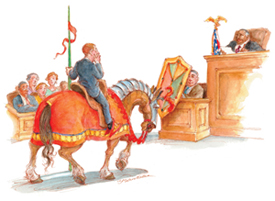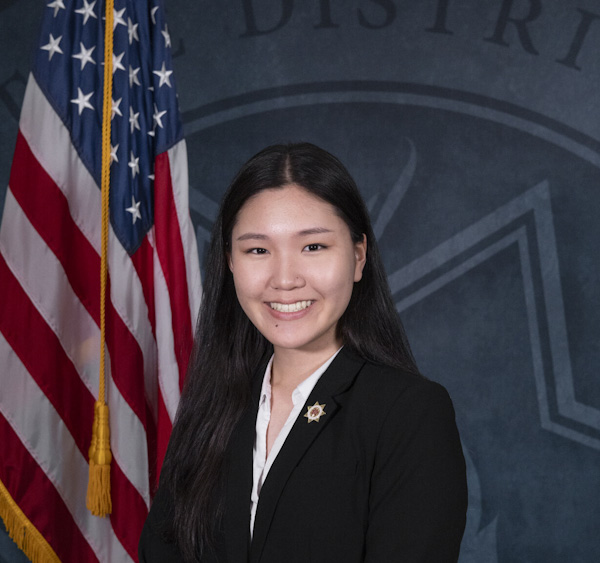The Point of Cross

Illustration by John Schmelzer
Now that Wednesdays are green chili stew days at Zapata’s, none of us were surprised when federal district Judge Horatio Standwell joined us for lunch.
“Have you seen this?” he said, dropping the latest county bar journal on the table. “Professor Warbler has written an article for litigators. It’s called ‘Cross-Examination: The Bully Pulpit for Arguing Your Case in the Middle of Trial.’ Professor Warbler delivered an autographed copy to my office just this morning.”
“Have you read it?” said Ernie Romero.
“I have,” said Judge Standwell.
“And?” said Sandy Ramirez.
“He told me it was to be the first chapter of a book he was planning for trial lawyers, called Creative Trial Techniques.”
“A book? Good grief!” said Flash Magruder, “I don’t think Vince Warbler’s ever tried a lawsuit in his life. Even the title of the article sounds a little over the top.”
“Trying to argue your case on cross could easily become improper,” said Dick Mudger.
“Yes,” said Judge Standwell. “Besides, you’ve got too many other things to think about during cross besides trying to do it as if it were part of your final argument.”
“But why is that a problem?” said Ernie Romero.
“Because,” said Angus, “trying to argue the case gets in the way of your most important job on cross—which is to be the real witness. The point of cross-examination is to let you testify while the person on the witness stand reluctantly agrees that what you say is true.”
“Aw, bishwah,” said Myra Hebert, the bar association politician who had been listening in from the next table and moved her chair over to ours. “The most important job on cross-exam is to show that the other side’s witnesses are all liars and brigands.”
Dick Mudger rolled his eyes toward the ceiling, and Ernie Romero said, “Judge, what’s your take on beating up the witness on cross?”
“Two things,” said Judge Standwell. “First, if the jury really likes the witness, you have just committed judicial seppuku. Second, even if the jurors don’t like the witness, they no longer need to use their verdict to punish the party that brought him to court. You’ve already done it with your cross.”
You could see Myra was going to say “Aw, bishwah” again, but she remembered she’d be talking to Judge Standwell and caught herself in the nick of time.
“Anyway, Angus,” said Sandy Ramirez, “why do you say that the point of cross-exam is to let the lawyer ‘testify’?”
RELISH THE RULES
“First of all,” said Angus, “because the rules were written to let you do it. You can automatically lead the witness on cross. You can’t lead on direct unless the witness is hostile or adverse, or if it’s to keep a forgetful, wandering witness on track.
“And when you lead, you’re actually testifying. So you’re the ‘real witness’ on cross. It’s your opportunity to tell what’s called ‘the rest of the story.’ And if you do it well, all the person on the stand can do is agree that what you say is true.
“But it’s still got to be within the scope of direct examination, doesn’t it?” said Ernie Romero.
“Of course,” said Angus.
“That’s why I call it the rest of the story. It’s what was deliberately left out of direct. And one of your most important jobs on cross is to lay the foundation for your impeaching evidence so that it’s obviously part of the story before you confront the witness with it.”
“What do you think of ‘Mad Dog’ McGinty’s new book, Killer Kross?” said Judge Standwell.
“I thought you’d never ask,” said Angus with a laugh. “I’ve actually read it. Have you?”
“I skimmed the table of contents,” said the judge. “How did it strike you?”
MAKE THE WITNESS WORK FOR YOU
“That brings up the second answer to Sandy’s question, ‘Why is the point of cross-examination to let the lawyer testify?’ ” said Angus.
“Lots of lawyers start their cross-exams by telling the witness, ‘I only have a few things I would like to clear up from your direct examination.’
“Don’t say that. It’s sending the wrong message to the jury. It’s not your job to fix your opponent’s direct or imply that anything you don’t attack is fine.
“It’s even worse when you go through the witness’s entire direct, attacking everything—which McGinty says you should do. His first chapter is called ‘Scorched Earth Kross.’
“Next, ‘because it was there’ may have been a good enough reason for Sir Edmund Hillary to climb Mount Everest. But it’s not a good reason for challenging a witness on cross unless it helps your theory of the case.
“Even more important,” said Angus, “don’t make the witness your own unless you must. Every time you use the witness to get information you need for your case—asking questions that start with who, where, what, when, how or why—you are sending the message that the witness can be relied on to give accurate information. You’re telling the jury, ‘You want the truth? Trust Mike Williams. I do.’
“And if you must use the witness as your own, be careful to separate your direct from your cross. Put it up front, not in the middle or at the end. Introduce your direct by saying something like, ‘Just a few minor points before we get started here’—and stand between the witness and the jury so that when he’s looking at you, he’s looking at the jury.
“Q: Mr. Reynolds, did you attend the Consolidated shareholders’ meeting on March 27, 2008?
“A: Yes, I did.
“Q. Was Mrs. Johnson present at that meeting?
“A: Not until 3:30 that afternoon, when it was nearly over.
“Q: I see. Thank you, sir. Now let’s turn to the summer of 2007.
“When your direct is over, change where you stand so that when the witness is looking at you, he’s not looking at the jurors. A new tension is created, subtly suggesting that the witness can no longer look them in the eye. And you should stand straighter, sound firmer and be a bit more formal.
“So now are we ready for the attack?” said Sandy Ramirez.
“If that’s what you call it, that’s what you’re going to do and that’s how you’re going to come across,” said Angus. “My own approach is to rarely attack any witness—and not on the spur of the moment. Never let Mongo—your inner beast—take over any part of the case, especially cross-examination.”
“So what am I supposed to do?” said Sandy. “Pretend I’m Ms. Goody Two-Shoes trying a lawsuit?”
“Hardly,” said Angus. “Be firm, careful, even tough when necessary. But remember, anger and rage are signs of defeat, not victory. And sarcasm is the last weapon of the defeated wit.”
“I wish I had a recording of all of this,” said Ernie.
“Thanks,” said Angus. “But don’t worry about not remembering all these ideas. Jimmy’s sitting right over there, taking notes that he’s probably going to put in his column.
“Besides, we’re not quite done. I want you to see one of the most powerful techniques for controlling any witness on cross-examination. It’s asking short, terse leading questions, using no legalese. Questions like that give the witness no wiggle room.”
“Oh, come on,” said Ernie. What would that do?”
“You’ll see,” said Angus. “Your name is Romero?”
Ernie paused. Angus said, “True?”
“Yes,” said Ernie.
“First name Ernesto?” said Angus.
“Yes.”
“You go by ‘Ernie’?”
“Yes.”
“Middle name is Vigil?”
“You might say that,” said Ernie.
“That means yes?” said Angus.
“Yes,” said Ernie.
“New topic,” said Angus. “Education. You went to law school?”
“If that’s what you want to call it,” said Ernie.
“Any reason why you don’t want to tell the jury whether you went to law school?” said Angus.
“No, I’m actually proud to be a lawyer,” said Ernie. “And I didn’t think this was going to work. But what you’re doing is powerful. Do you think I could learn to do it?”
“Only if you practice with people who give you a hard time before you try it in court,” said Angus.
“Awesome!” said federal district Judge Horatio Standwell.
Jim McElhaney is the Baker and Hostetler Distinguished Scholar in Trial Practice at Case Western Reserve University School of Law in Cleveland and the Joseph C. Hutcheson Distinguished Lecturer in Trial Advocacy at South Texas College of Law in Houston. He is a senior editor and columnist for Litigation, the journal of the ABA Section of Litigation.



